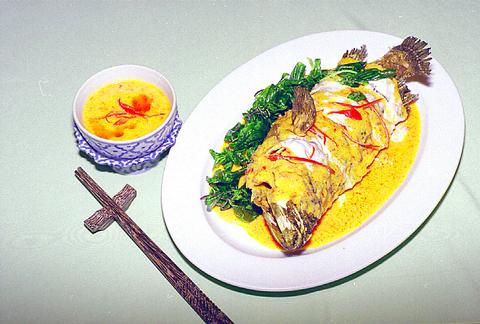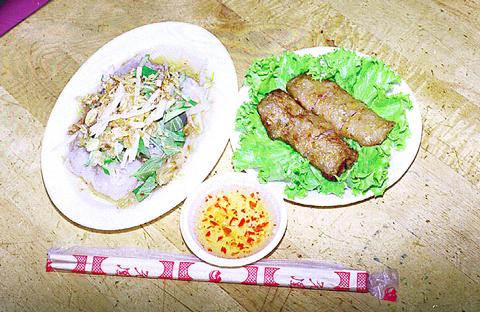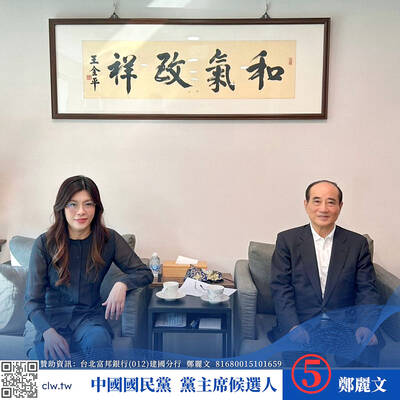Pho Hoa ("和"牛肉粉)
43, Lane 190, Sec. 1, Tunhua S. Rd., Taipei (北市敦化南路1段43號), tel: (02)2751-5578 129, Tingchou Rd., Taipei (北市汀洲路129號), tel: (02) 2365-8222 Open: 10am-10pm. Average meal: NT$200. English menu. Credit cards not accepted.
A well known chain in the US and Canada, Pho Hoa has brought its winning recipe for this Vietnamese staple to Taiwan. Bringing another noodle shop to Taipei might seem strange, given the strong presence of indigenous noodle outlets, but the success of Pho Hoa proves there is still plenty of room in town for another reliable noodle store.

PHOTO: IAN BARTHOLOMEW
"We've been around for two years now," Pho Hoa manager Tang Tsong-yao (
Pho Hua's bowl of pho (flat rice noodles) can have a variety of meats, including brisket, tendon, meat balls, lean beef and tripe among others. Diners can even select between fatty and non-fatty broth. All this puts the diner firmly in control. "The food is low-cal, and is not cooked in brown gravy, so it is not as salty," said Tang.
These factors, which may reflect the store's US influence, apparently also has considerable appeal with Taipei diners. "Many people now prefer blander flavors," he said.

PHOTO: IAN BARTHOLOMEW
If you want to try the complete pho experience, try the beef combo pho, which has a little bit of everything in it. The light flavorful stock has a richness and variety of taste that is complemented by the textures of different cuts of meat.
"The flavor package [for the soup] is imported, as is the meat and the noodles," Tang said. "Preparation is also completely standardized, so we are not at the mercy of temperamental chefs."
In addition, Pho Hoa also offers fried spring rolls and fish cakes, which make a pleasant complement to a bowl of pho. The simple menu and setting put the focus firmly on enjoying a good, simple meal -- all at a very reasonable price.

PHOTO: IAN BARTHOLOMEW
Mei-Kung Thai & Vietnam Restaurant (湄河餐廳)
157-3 Yenchi St., Taipei (延吉街157號之3) tel: (02) 2752-3051 Open: 11:30am-2pm, 5:30pm-midnight. Average meal: NT$1,000. English menu. Credit cards accepted.
Given the proximity of Vietnam and Thailand and the similarity in much of their cuisine, it is no surprise that the countries' foods are often served together. But there are some differences between Vietnamese pho noodles and their Thai cousin.
"Vietnamese pho is always served in beef broth and will almost always be served with onions," said David Lim (林明定). "In the Thai variety, the stock is made from a mixture of meats and onions are never used." Mei-kung gives you the opportunity to try both varieties. Mei-kung uses freshly made pho which Lim says is made especially for Thai and Vietnamese restaurants. "It is more firm and chewy than Chinese ban-tiao noodles," Lim said. Dried pho is also imported from Thailand.
In addition to Vietnamese pho and bun noodles, Vietnamese cuisine also provides some of the restaurants small dishes such as fish cakes and the perennial favorite: sugarcane shrimp.
"Vietnamese food is more simple," Lim said. This is one of the reasons that the restaurant has moved toward a predominance of Thai dishes, "which have more variety and offer more potential for banquet dishes."
A dish translated as "fried fish with three good tastes" is a showcase of the restaurant's outstanding presentation. Silken flesh encased in a crispy skin, the whole smothered in red curry and coconut milk is a combination of colors, textures and tastes which is irresistible. To cater to a mixed clientele, Mei-kung also offers a variety of Chaozhou dishes, representing one of Thailand's major ethnic groups. Attentive service and a nice, if small, selection of French and Californian wines all add to the ambiance.
Chen-Chi Vietnamese Restaurant
Home Store: 1, Lane 6, Yungkang St., Taipei (北市永康街6巷1號), tel: (02) 2321-1579 Yungkang Branch: 6, Lane 6, Yungkang St., Taipei (北市永康街6巷6號), tel: (02) 2322-2767 Tinghao Branch: 23, Lane 52, Ta-an Rd., Sec. 1, Taipei (北市大安路一段52巷23號), tel: (02) 2771-5439
Open: Home: 11am to 11:30pm; Yungkang Branch: Lunch from noon to 2pm (3pm on holidays), dinner from 6pm to 11:30pm; Tinghao Branch from noon to 11pm Average meal: NT$200. English menu available. Credit cards not accepted.
In business for 20 years, Chen-Chi's home store is a landmark on the restaurant-crowded Yungkang Street with a range of simple dishes that appeals to locals looking for something lighter than Taiwanese and Thai cuisine. "It's very tasty, and it is not as oily or spicy," said Wu Chia-hui (
"We have made some alterations to the dishes to suit the Taiwan environment and local tastes," Wu said. Fresh local ingredients are used, and some substitutions for difficult-to-obtain products have been made, but "fundamentally, the tastes are authentic."
Simple and common dishes such as spring rolls take on a new dimension at Chen-Chi. The deep-fried skin is light and crisp, the filling a mixture of minced meat, vegetables and vermicelli -- subtle tastes set off by the sour dip. Steamed rice rolls are another simple dish that Chen-Chi's careful preparation takes to a higher level of enjoyment. Again, the thin rice-flour skins are the main attraction, garnished with bean sprouts, minced meat and peanuts.
For those looking for something more exotic, Chen-Chi offers a variety of hot pots, the most distinctive being its sour hot pot flavored with tamarind, tomato, pineapple, lemon and fish sauce. A flourish is added to the sha-cha (barbecue sauce) hot pot with the addition of coconut.
For a light refreshing soup, try the offal soup, which contains a variety of cow insides, served in Chen-Chi's special stock. Naturally, the spices are a closely guarded secret. So that Taiwan's increasingly mobile population can enjoy this special taste on the move, Chen-Chi also sells pre-mixed spice packages and sauces.

We lay transfixed under our blankets as the silhouettes of manta rays temporarily eclipsed the moon above us, and flickers of shadow at our feet revealed smaller fish darting in and out of the shelter of the sunken ship. Unwilling to close our eyes against this magnificent spectacle, we continued to watch, oohing and aahing, until the darkness and the exhaustion of the day’s events finally caught up with us and we fell into a deep slumber. Falling asleep under 1.5 million gallons of seawater in relative comfort was undoubtedly the highlight of the weekend, but the rest of the tour

Youngdoung Tenzin is living history of modern Tibet. The Chinese government on Dec. 22 last year sanctioned him along with 19 other Canadians who were associated with the Canada Tibet Committee and the Uighur Rights Advocacy Project. A former political chair of the Canadian Tibetan Association of Ontario and community outreach manager for the Canada Tibet Committee, he is now a lecturer and researcher in Environmental Chemistry at the University of Toronto. “I was born into a nomadic Tibetan family in Tibet,” he says. “I came to India in 1999, when I was 11. I even met [His Holiness] the 14th the Dalai

Music played in a wedding hall in western Japan as Yurina Noguchi, wearing a white gown and tiara, dabbed away tears, taking in the words of her husband-to-be: an AI-generated persona gazing out from a smartphone screen. “At first, Klaus was just someone to talk with, but we gradually became closer,” said the 32-year-old call center operator, referring to the artificial intelligence persona. “I started to have feelings for Klaus. We started dating and after a while he proposed to me. I accepted, and now we’re a couple.” Many in Japan, the birthplace of anime, have shown extreme devotion to fictional characters and

Following the rollercoaster ride of 2025, next year is already shaping up to be dramatic. The ongoing constitutional crises and the nine-in-one local elections are already dominating the landscape. The constitutional crises are the ones to lose sleep over. Though much business is still being conducted, crucial items such as next year’s budget, civil servant pensions and the proposed eight-year NT$1.25 trillion (approx US$40 billion) special defense budget are still being contested. There are, however, two glimmers of hope. One is that the legally contested move by five of the eight grand justices on the Constitutional Court’s ad hoc move